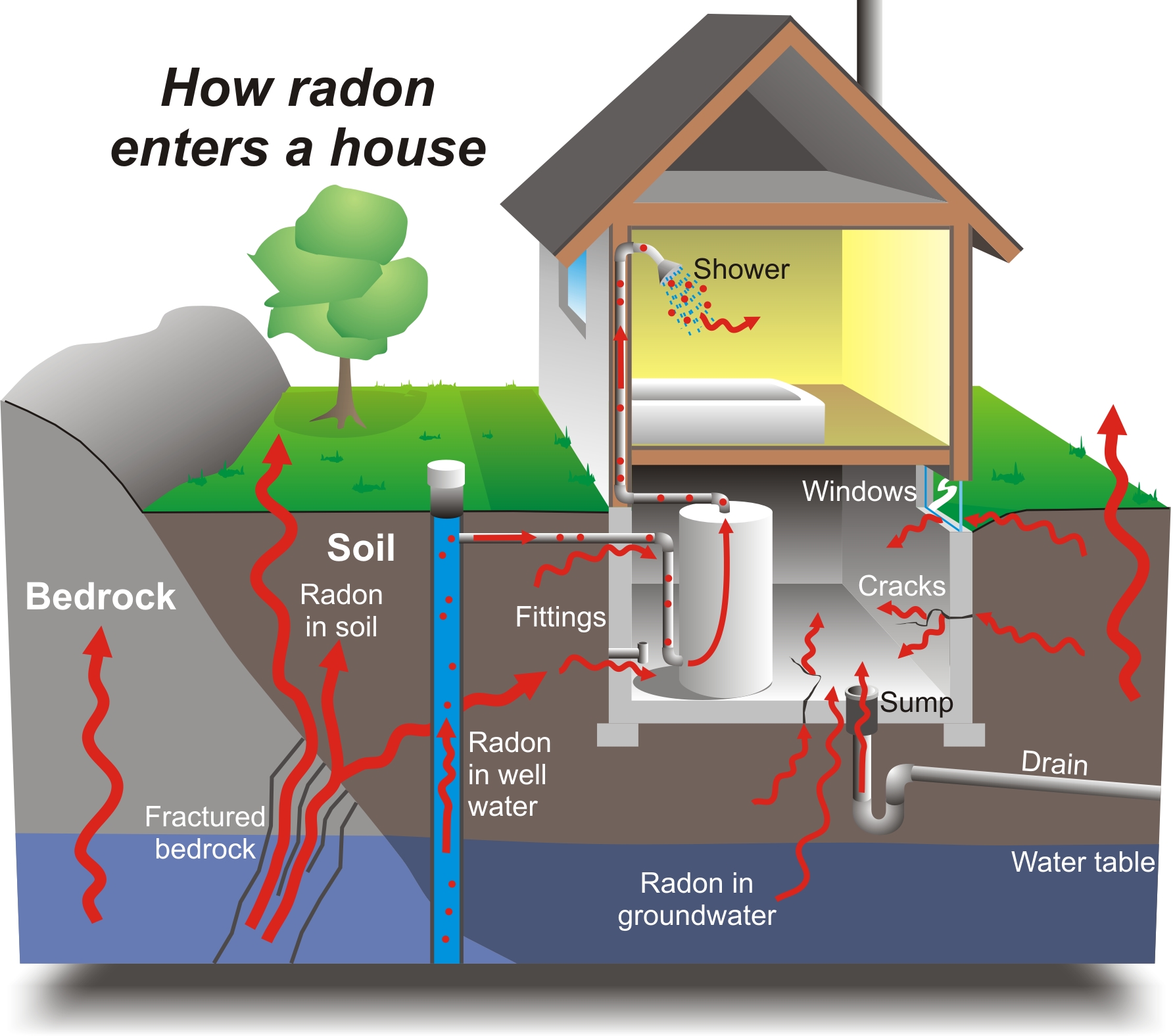Radon

WHAT IS RADON?
Radon is an invisible, odorless radioactive gas that is formed naturally by the breakdown of uranium in soil, rock and water. Radon decays quickly, giving off tiny radioactive particles. When radon escapes from the ground to the outdoors, it mixes with fresh air, resulting in concentrations too low to be of concern. But when radon seeps into an enclosed space like a building, it can accumulate in high concentrations and become harmful.
HOW DOES IT GET INTO THE BUILDING?
For most of the year, the air pressure inside a building is lower than the pressure in the soil surrounding your foundation. This difference in pressure can draw air and other gases in the soil, including radon, into the building.
Gas containing radon can seep into cracks and openings in buildings and homes, especially on the lower floor, basement or crawlspace areas. Radon can enter a building any place it finds an opening where the building contacts the soil:
- cracks in foundation walls or floor slabs;
- unfinished floors;
- construction joints;
- gaps around service pipes, support posts, window wells, floor drains, sumps;
- cavities inside walls;
- etc.
Radon can get trapped inside buildings especially in main level floors, basements and crawlspaces that don’t have good ventilation (airflow).
Almost all buildings will have some radon. The levels can vary dramatically even between similar homes located next to each other. The amount of radon in a building depends on many factors including:
- Soil Characteristics: Radon concentrations can vary enormously depending on the uranium content of the soil. As well, radon flows more easily through some soils than others, for example, sand versus clay.
- Construction Type: The type of building and its design affect the amount of contact with the soil and the number and size of entry points for radon.
- Foundation Condition: Foundations with numerous cracks and openings have more potential entry points for radon.
- Occupant Lifestyle: The use of exhaust fans, windows and fireplaces, for example, influences the pressure difference between the house and the soil. This pressure difference can draw radon indoors and influences the rate of exchange of outdoor and indoor air.
- Weather: Variations in weather (e.g. temperature, wind, barometric pressure, precipitation, etc.) can affect the amount of radon that enters a building.
Because there are so many factors, it is not possible to predict the radon level in a building; the only way to know for sure is to test.

WHY IS IT HARMFUL?
You can't see radon, smell it or taste it. When radon is inhaled, the radioactive particles can damage the cells that line the lung. Long-term exposure to radon can lead to lung cancer. If you live in a building with high radon levels or if you spend a lot of time in one, you are at higher risk for lung cancer. If you smoke and you live in a home with a high level of radon, you are at an even higher risk for lung cancer. For children that spend considerable time at school, minimizing radon levels in schools can significantly reduce their potential lifetime radon exposure.
The only known health risk associated with long-term exposure to radon is an increased risk of developing lung cancer. The level of risk depends on the concentration of radon and duration of exposure. Radon is the second leading cause of lung cancer in Canada and the leading cause of lung cancer for smokers. Its exposure is estimated to be the cause of 16% of lung cancers in Canada. Recent research has also determined that radon exposure may contribute to the development of Multiple Sclerosis and Leukemia.
RADON TESTING IN PEMBINA TRAILS SCHOOL DIVISION:
In 2011 the Pembina Trails School Division participated in a joint project with the University of Manitoba and Department of Labour to test for radon in schools. At the time of the project only schools with basement level classrooms were included in the testing. Final test results revealed radon levels below the Health Canada requirement of 200 Bq/m3 in all buildings.
Due to the recent changes (January 2016) in the Health Canada guideline for radon testing, the school division began testing all occupied rooms found on the main floor/basement/crawlspace areas that are occupied for four hours or more to ensure that radon levels fall within the Health Canada guidelines. Testing will take place over the next three years.


Please provide your question and email address in the fields below.
Your question has been successfully submitted.
CloseThank you.